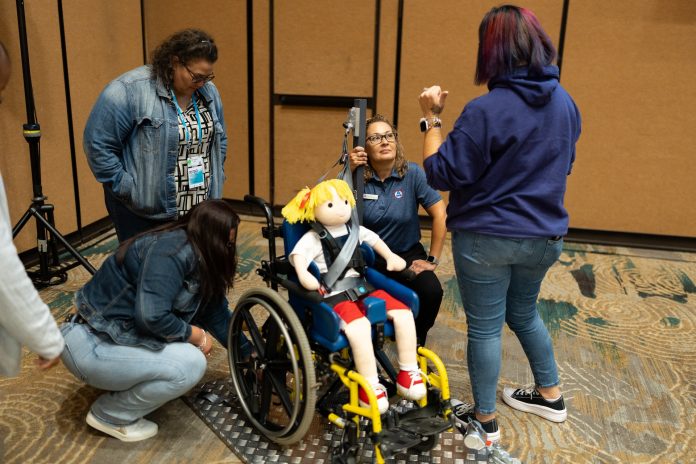It is crucial that Individualized Education Program (IEP) committees are familiar about the school district vehicles that are available to transport children with disabilities. This information is needed in order to address the role of the IEP committee in school
transportation vehicle selection. It is important that IEP committees are knowledgeable about appropriate vehicle selection decisions versus decisions that are within the discretion of the school district transportation office.
A school district can comply with the Individuals with Disabilities Education Act (IDEA) provision for the related service of transportation by utilizing a number of transportation options. These options include providing their own fleet of vehicles or contracting with private providers. Allowable transportation vehicle selection is not addressed in the IDEA. However, transportation vehicles used must be in compliance with federal and state regulations, and written school board policies and procedures.
The role of the IEP committee in school transportation vehicle selection for children with disabilities is an important safety consideration. This subject should be discussed by informed school transportation and special education personnel and disseminated in writing to IEP committees.
Historically, school transportation writings concerning children with disabilities provide guidance regarding the importance of the IEP committee in making informed transportation decisions. The U.S. Department of Education’s Office of Special Education Programs (OSEP) in 1995 clarified that transportation should be discussed during both the evaluation and the IEP process. School districts were apprised that the results of a child’s evaluation are essential in designing appropriate transportation programs for children with disabilities. (Letter to Smith, 23 IDELR 344, OSEP 1995). This letter further clarifies that it is the responsibility of a child’s IEP team to determine whether transportation is necessary for a child to receive a free appropriate public education (FAPE) and that the required transportation and supports necessary be provided at no cost to the parents.
However, this letter is silent on the matter of school transportation vehicle selection. Additional guidance is found in the Notice of Interpretation, IDEA 1999 regulations, Appendix A, Question 33. It states, “In determining whether to include transportation in a child’s IEP, and whether the child needs to receive transportation as a related service, it would be appropriate to have at the IEP meeting a person with expertise in that area….” Once again, the regulations are silent on the topic of vehicle selection.
The COVID-19 pandemic prompted quick consideration for the extension of vehicle selection options for school districts that are in compliance with federal and state laws for transporting children with disabilities. As such, IEP committees immediately needed guidance about allowable safe transportation vehicle options.
During and post-COVID, it was not atypical to receive requests for technical assistance regarding allowable school transportation vehicle selection decision criteria. I remind individuals requesting technical assistance to consider the following factors in addition to existing federal and state laws prior to approving a school transportation vehicle other than a yellow school bus: (1) the child’s age; (2) the child’s cognitive, intellectual, behavioral, communication, and independent mobility functional level; (3) the child’s required supervision; (4) required equipment; and (5) the impact of the child’s disability to ride safely in a specific type of vehicle, other than a yellow school bus. The list above does not include all potential circumstances. Another IEP committee consideration in vehicle selection is meeting the least restrictive environment (LRE) mandate in the IDEA, meaning that to the maximum extent appropriate children with disabilities are integrated with non-disabled peers.
An IEP committee cannot mandate or determine the selection of the provider for transportation services, but it is within its authority to specify the type of transportation, staffing needs and special equipment required.
When school districts fail to specify the appropriate terms and conditions of the transportation services provided in a child’s IEP, a procedural violation complaint can be filed. School districts have been ordered to amend the IEP to specify the type of vehicle, adaptive equipment, number of personnel required, and the extent of services to be provided to a specific child.
IEP committee decisions about transportation services should be written into the IEP. The type of transportation vehicle selection should be included in the IEP. The precise transportation that a school district provides for a child with a disability should always depend on the unique needs of the child and should never be a unilateral decision. Remember, the participation and input of parents into this process is critical, and the failure to include parents in this matter should be avoided.
In summary, an increasing number of school districts are turning to alternative forms of transportation to help fill the gaps created by the nationwide school bus driver
shortage. This is a primary reason that IEP committees need to be fully informed about all options for safe transportation. Keeping up with school transportation allowable vehicles options is an IEP committee responsibility. Determinations regarding school transportation vehicle options used in a school district should be commensurate with all laws governing school transportation, specific to children with disabilities.
When it comes to school transportation vehicle decisions, the IEP committee should not be sidetracked by a lack of knowledge or information. Avoid unnecessary mistakes by inviting transportation personnel to participate in recommendations and decisions concerning a vehicle other than the yellow school bus. The school transportation industry is encouraged to have discussions about applicable allowable school transportation vehicle standards, including all relevant colleagues, about what is the most efficient, effective and safest way to serve children with disabilities, when an alternative to the yellow school bus is a suitable option.
Editor’s Note: As reprinted in the January 2024 issue of School Transportation News.
Related: IEP Meetings: TSD Conference Panel Discusses the Who, When & What
Related: TSD Conference Rewind: Including Evacuation Plans in IEPs
Related: Webinar: Technology, Education Proven to Reduce Illegal School Bus Passing
Related: (STN Podcast E190) 2023 in Review: Top Student Transportation Stories of the Year
















